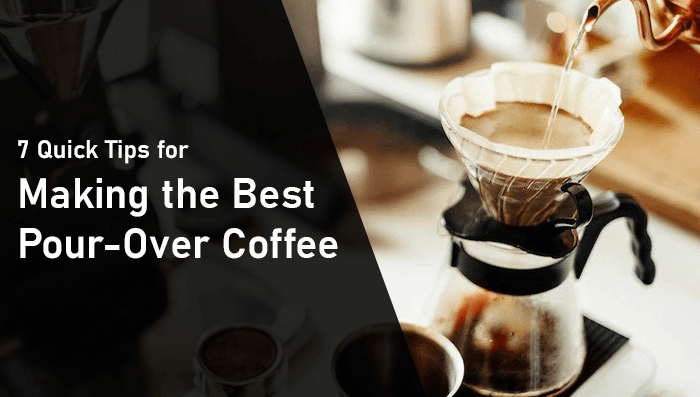7 Quick Tips for Making the Best Pour-Over Coffee

There’s a reason pour-over coffee has soared in popularity in recent years—it is highly customizable and accentuates the natural flavors of the coffee grounds.
Pour-over is a time-consuming coffee brewing method, but it brings out a richer, more complex taste, making it worth it.
There are numerous pour-over brewers available in the market. You can use a Clever Dripper, a Hario V60, or a Chemex. More than the type of brewer, what matters is the correct way to bloom and brew coffee.
Brewing pour-over coffee involves placing ground coffee in a paper filter and pouring hot water over it. As the water drains through the grounds, it exits the bottom of the filter and into your mug. Voila, your vibrant coffee!
Making pour-over coffee is a manual process that gives you more control over brewing. So you can experiment with brewing time, temperature, and different coffee beans until you find the perfect strength and flavor.
While all beans work fine for pour-over coffee, some flavors and blends will come across better than others.
Those with light and medium roasts are the best pour-over coffee beans if you prefer floral and fruity flavors. Alternatively, dark roast coffee beans will suit your palate if you enjoy bitter flavors.
A pour-over coffee that hits the spot requires a lot of patience and practice. To save you from trouble and errors, I will give you straightforward tips to achieve the best results.
1. Use the Right Equipment
Having the right tools to achieve the perfect pour-over coffee is essential. Using the right equipment is necessary for performing all the brewing steps precisely, so there is less room for error.
You will need the following:
A Pour Over Coffee Maker
Considering its classic design and thermal qualities, the Hario V60-02 is my favorite. You can use any other brewer, such as a Chemex, the Kalita wave, or Melitta Pour over.

A Coffee Grinder
Use a premium quality grinder. Make sure it grinds coffee beans with consistency and uniformly. Uneven grind consistency can lead to bitter extractions.

A Kettle
You can get an electric or stovetop version of a kettle. I recommend using a gooseneck kettle as its spout helps pour water accurately and gently.

A Scale
Scales measure coffee grounds and water precisely. It helps you achieve the same flavor and balance whenever making your coffee.

A Timer
Especially when you are new to home brewing, a timer works as a charm. It can help you prevent over-extraction or under-extraction of your coffee.

A Thermometer
You will need a thermometer to monitor the water temperature. If the water is too hot or too cold, it will not extract the coffee grounds correctly.

2. Use the Right Grind
Each coffee brewer requires a slightly different grind size, but you can start with a medium grind for your pour-over coffee.
You can tweak the grind size a bit if a medium grind doesn’t produce good coffee. Try grinding your beans more finely if your coffee tastes too weak or sour but less finely if it tastes bitter or harsh.
Another way to find the right grind for your coffee is to notice the brew time. A proper grind should allow the coffee to drip through the cone filter within 2.5 to 4 minutes. You need to change the grind size if it takes more than 4 minutes or less than 2.5 minutes to brew.
3. Brew on Optimal Temperature
Before you pour the water over the ground beans, the water should be between 195 and 205 degrees Fahrenheit. It is the optimal temperature for dissolving coffee grounds while drawing out their flavors.
If the water is too hot, it may over-extract the grounds, resulting in bitter coffee. On the other hand, it will only extract the coffee grounds properly if the water is hot enough.
Some pour-over kettles have a built-in thermometer gauge, making it easy to monitor the temperature. If you don’t have that, an inexpensive thermometer works equally well.
Tip: Water can lose its heat very quickly, so using a copper kettle will be a plus as it keeps the temperature of water stable.
4. Correct Coffee-to-Water Ratio
The coffee-to-water ratio determines the strength of your coffee, which is one of the easiest factors in the brewing process to control.
The standard ratio for pour-over coffee is 16:1. For every gram of coffee grounds; you will add 16 grams of water. As everyone’s coffee preferences vary, you don’t have to follow the exact ratio.

This ratio is a guideline to check if it suits your coffee preferences. If it is too sweet for you, you can adjust the ratio between 1:17 and 1:18. Using more water will increase the coffee’s extraction, making it a more robust cup.
Make sure to note the ratio so you know if there are any adjustments to make the next time you brew your coffee.
5. Use the Right Water
As a cup of coffee is 98% water, the water quality can make or break its taste. Use clean or filtered water for your coffee. In addition to being healthy for your body, filter water also enhances the taste of coffee.
You should keep this tip in mind for a more flavorful cup.
6. Let it Bloom
When using the pour-over method, “blooming” is necessary to extract maximum flavor. During roasting, carbon dioxide builds up in coffee grounds. The trapped gases in coffee can prevent consistent extraction.
To avoid uneven extraction, pour 10% of the total amount of water over the coffee grounds. Pour the water evenly over the coffee, creating a whirlpool to soak them completely.
As the coffee grounds start to rise and bubble, they emit gases. Wait 30 to 45 seconds for the coffee grounds to settle before pouring the rest of the water.
7. Rinse the Filter
This tip is essential for your coffee not to taste like paper. Yes! You read that right!
Your coffee can have a hint of a papery taste if you don’t rinse your filter before using it. The filter can have a cardboard odor and woody taste that you need to rinse off.
To rinse it off, place the filter in the brewer and pour hot water. Keep pouring water for five seconds, soaking all sides as well. Once you are sure the filter is entirely wet, discard the water.
Note: There are a variety of filters available on the market; paper filters, cloth filters, metal filters, etc. Watch this video to find out which works best.
Conclusion
Using a pour-over brewer at home makes a crisp, clean cup of coffee. Many coffee enthusiasts prefer this brewing method because it makes coffee full of flavor and aroma. Plus, it’s mesmerizing to watch coffee slowly drip from the filter into the carafe.
With these tips in hand, you can make a decent brew and tweak it until it becomes one of your favorites. Make sure to use the right tools and techniques to perfect your pour.
